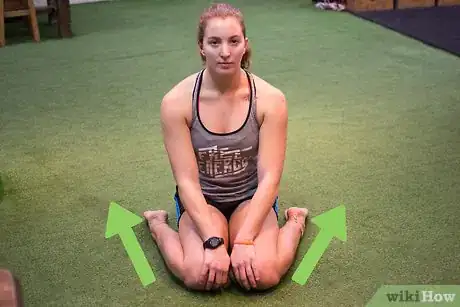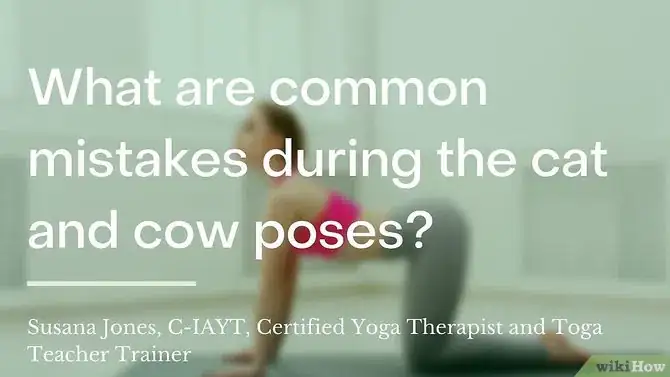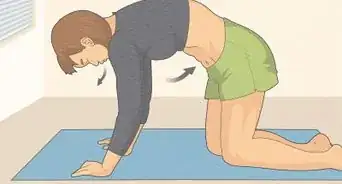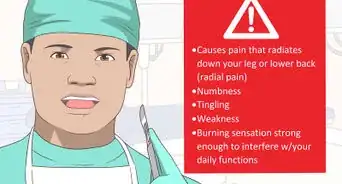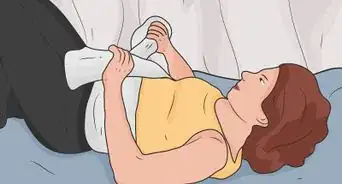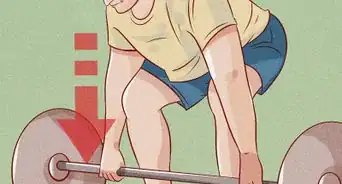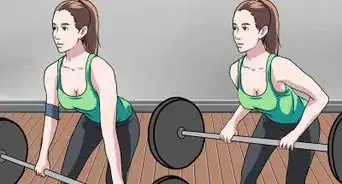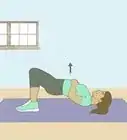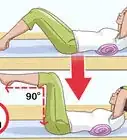This article was medically reviewed by Robert Rice, DC. Dr. Rice is a Chiropractic Physician and Owner of Shiloh Chiropractic in Illinois. Dr. Rice started Shiloh Chiropractic in 2006. He received his DC from Logan University of Chiropractic in 2006.
There are 9 references cited in this article, which can be found at the bottom of the page.
wikiHow marks an article as reader-approved once it receives enough positive feedback. In this case, 91% of readers who voted found the article helpful, earning it our reader-approved status.
This article has been viewed 871,505 times.
Your back is prone to injury. You can twist it, wrench it, or even just sleep on it funny. If your back muscles aren't stretched regularly, they are far more likely to get hurt. Stretching your back regularly can help keep your muscles flexible, which will help prevent strain and back pain. You can stretch your back while doing yoga, exercising at home or in the gym, or even right in your office.
Steps
Doing Yoga to Stretch Your Back
-
1Do the cat pose. Get down on your knees and place your hands in front of you with your palms on the ground. Make sure that your fingers are pointed away from you. Then move your head down and your spine up while rounding out your back and stretching out your spine.[1]
- If you have a neck injury, speak to your doctor about whether or not this pose is appropriate. If your neck is simply sore, just be sure to keep your neck in line with your torso instead of tucking your chin toward your chest.
- Also, if you have difficulty rounding your upper back, have a friend place a hand in the middle of your shoulder blades while you push your vertebrae against it.
-
2Transform your cat pose into a dog pose. Start from the cat pose (on your hands and knees with a rounded spine, hands flat with fingers pointing away from you). Slowly straighten your back and then keep going until your spine is concave and you are looking up. Hold for five seconds, then transition back to cat pose.[2]
- The gentle tension and release in the spine helps to increase flexibility and to ease lower back pain.
- The dog exercise is also known as the cow exercise in yoga.
Advertisement -
3Do the crocodile pose. To do this pose, you should lie flat on your stomach and then bend your elbows and place your palms under your armpits. Then gently push up your chest and upper body until your chest is a few feet up from the ground.
- The crocodile pose, particularly if you practice yogic breathing as you perform the exercise, will help to decrease feelings of anxiety in addition to stretching the back.[3]
-
4Do the hero pose. Sit down with your legs bent at the knees and your calves and feet at your sides, with the soles of your feet facing up. The big toe of each foot should be touching or just an inch or two away from your sides. Place your hands on your lap. The hero pose, as well as stretching your lower back, will relieve tired legs at the end of a long day.
Using Other Stretches for Your Back
-
1Do an upward-facing hip twist. This exercise twists the lower body in the opposite direction of the upper body, lengthening and flexing the spine. First, lie down on your back and then bend your left knee up and move it over to your right side. Keep your arms flat on the ground and look up, or even look to your left for an extra stretch.
- As you twist your body from side to side, make sure to use a slow and fluid motion to avoid injury. Keep your abdominal muscles contracted to support your back muscles.
- Hold for 10 seconds and then release. Do the same for your other leg.
-
2Do a stability ball back extension. With this exercise, you will drape your body over an exercise ball before stretching to extend your back. Drape yourself over the ball so your stomach and pelvis are comfortably resting. Then place your hands behind your head, as if you were doing a sit-up, and stretch your body upward, making your back concave. The stability ball provides extra support and helps the spine to curve naturally, as you stretch your back.
- Engage your glutes and your hamstrings so that you don’t overarch your back and so that you have a stable base for the exercise.[4]
-
3Do a 90/90 neutral back stretch. This stretch helps you to relax both your back and your hamstrings. First, lie flat on your back and place your legs together. Then, lift your knees up so that your thighs are perpendicular to the ground while your shins are parallel to the ground. Keep your arms at your sides as you feel the stretch in your back.
- From the 90/90 position, you can gently pull your knees into your chest to stretch the back even further.
- You can also tilt your legs to the right and left sides, keeping the small of your back pressed into the floor.
-
4Do a sitting spinal twist. This exercise requires you to sit on the floor and to twist your upper body to either side at the waist, stretching the back. First, sit down with your legs stretched out. Then, tuck in your left knee until it faces up and then move it over your right thigh. Keep your right leg extended while your left knee is facing upwards, and twist to your left side. Place your right elbow to the side of your left knee to intensify the stretch. Hold the stretch for at least 20 seconds and repeat it on your other side.
- Focus on stretching your body upward as well as to the left or right.
- If you're stretching to the left, try looking over your left shoulder for a bonus. Follow the same process on your right side.
-
5Do an upper spinal rotation. Performing this stretch will help you to increase the flexibility of your upper back. Breathe deeply during the exercise, expanding the lower kidney area of the back as the lower rib cage opens up.[5]
-
6Do the seal pose in Pilates. The seal pose requires good flexibility and should be avoided if you have a back injury. However, for those in good condition, the seal pose will round out the lower back while strengthening the abdominal muscles. First, sit down on the ground, then bend your knees. Lift your legs until your thighs are almost vertical to the ground with your shins pointed outward. Place your feet together but create a space between your shins and thighs.
- Then, move your forearms through the space between your thighs, tuck them under your calves, and reach out to wrap them around your ankles.
- Hold this pose for at least 20 seconds if you feel comfortable with it.
Stretching Your Back at the Office
-
1Do a seated twist. This is a good stretch for your back without getting up from your chair. To do a seated twist, simply sit upright with your back erect, and slowly twist to one side from the waist, moving your waist, stomach, back, and shoulders all in one direction. Once you have twisted to one side for 15-20 seconds, you can revert to the middle position and then twist to the other side. [6]
- Make sure to do this slowly and carefully. If you twist too quickly or too far to one side, you can strain your neck or back. Try to avoid twisting to the point of causing a "pop," as this can cause misalignment.
- To deepen the twist, you can place one hand on your opposite knee, and gently push back against it. If you are twisting to the left, place your right hand on the outside edge of your left knee.
- Look over your left shoulder if you are twisting to the left. If you are twisting to the right, look over your right shoulder.
- You can also place your arms on the side of the chair that you're stretching towards. If you are stretching toward the left, then place both arms on the left side of your chair.
-
2Roll your shoulders. You can do this stretch, not only at your office, but while you are walking around town, sitting in your car, or even in the shower. To complete this stretch, sit upright with your back erect. Roll your shoulders back in a circular motion 10 – 15 times, and then pause, and roll them forward for the same amount of times. Repeat at least five sets of the backward and forward motion.
- Look straight ahead while you are rolling your shoulders so that you don't strain your neck muscles while you perform this technique.
-
3Give yourself a hug. This simple move stretches your shoulders and upper back. Place your right arm over your left shoulder and your left arm over your right shoulder, as if you were giving yourself a hug. Hold this position for at least ten seconds, breathing in and out to relieve the tension from your body.[7]
-
4Do the "leg hug." This move will stretch your back, neck, and shoulders. First, sit on the edge of a stationary chair. If the chair has wheels, wedge it against a desk or a wall. Place your feet together flat on the floor. Then lean over toward your feet, so your chest rests on or near your knees. Let your arms fall to the floor as if you are a rag doll. Then place your hands around your legs, with your right or dominant hand grabbing the opposite wrist, forearm, or even elbow.[8]
- Hold this position for at least 10 seconds and then release it. Repeat it at least two times.
-
5Stand and touch your toes. This stretch is simple but effective and stretches your upper and lower back. This stretch should push your hamstrings more than your actual back. Your spine extends all the way to your tailbone. So keep your back and butt on an even place. Touch your toes and then gradually try to straighten your legs.
- Hold the stretch for at least ten seconds, come up, and repeat the stretch at least five times.
-
6Do the forearm shoulder stretch. This technique is effective not only for stretching your shoulders but for stretching your upper back. You can do this stretch without getting up from your chair. Simply take your right arm and move it to the left side of your body, so your upper arm moves across your chest and your forearm is placed over the inside of your left elbow. Stretch up your left forearm so your right forearm is "trapped" between your left bicep and elbow, and move it closer toward your body as you feel the deep stretch in your right shoulder.[9]
- Hold the stretch for at least 10 – 15 seconds.
- Repeat this process with your left side.
-
7Stretch your upper back. Simply sit down with a straight spine and reach your hands straight in front of you, making them parallel to the ground. Then, press your palms gently into each other. Round your back slightly and lean forward for 20 – 30 seconds, pretending like you're stretching over a large round ball. Let your head and neck relax as you try this move. Return to the sitting position with your hands at your sides and repeat this process at least five times.[10]
Expert Q&A
-
QuestionWhat are common mistakes during the cat and cow poses?
 Susana Jones, C-IAYTBased in San Diego, Susana Jones is a Yoga Therapist and Educator with 12 years of experience serving groups, individuals and organizations. She is certified with the International Association of Yoga Therapists, registered as an E-RYT 500 with Yoga Alliance and holds a Bachelor’s degree from the University of Colorado. Susana offers therapeutic yoga to private clients through Shakti Urbana and mentors students of the internationally accredited Soul of Yoga. Susana dedicates her work to peaceful living on a healthy planet.
Susana Jones, C-IAYTBased in San Diego, Susana Jones is a Yoga Therapist and Educator with 12 years of experience serving groups, individuals and organizations. She is certified with the International Association of Yoga Therapists, registered as an E-RYT 500 with Yoga Alliance and holds a Bachelor’s degree from the University of Colorado. Susana offers therapeutic yoga to private clients through Shakti Urbana and mentors students of the internationally accredited Soul of Yoga. Susana dedicates her work to peaceful living on a healthy planet.
Certified Yoga Therapist & Educator
Warnings
- If you have any pre-existing chronic back problems, injuries, or are pregnant, then consult your doctor before attempting any of these stretches. You don't want to wrench your back or cause any further damage.⧼thumbs_response⧽
- If you feel any strain in your back while performing these exercises, stop immediately. Rest for a few days before attempting the stretches again. If you continue to experience problems, consult with your medical or chiropractic physician before proceeding.⧼thumbs_response⧽
Things You'll Need
- Yoga mat
- Exercise ball
- Bench
References
- ↑ http://www.yogajournal.com/poses/2468
- ↑ http://yogasite.com/postures.html
- ↑ https://yogainternational.com/article/view/diaphragmatic-breathing-in-3-key-yoga-poses
- ↑ http://healthguides.healthgrades.com/article/10-simple-exercises-to-avoid-back-pain
- ↑ http://www.safe-stretch.info/spinal-twist/
- ↑ http://www.fitday.com/fitness-articles/fitness/stretching/4-back-stretches-for-the-office.html#b
- ↑ http://www.webmd.com/fitness-exercise/features/stretching-exercises-at-your-desk-12-simple-tips?page=2
- ↑ http://www.webmd.com/fitness-exercise/features/stretching-exercises-at-your-desk-12-simple-tips?page=2
- ↑ http://www.ccohs.ca/oshanswers/ergonomics/office/stretching.html
- ↑ http://www.ccohs.ca/oshanswers/ergonomics/office/stretching.html
- Videos provided by PsycheTruth
About This Article
If you need to stretch your back, lie flat on the ground, then bring your left knee up to your chest and move it to your left side. Use a slow, fluid motion to avoid injuring your back. Hold this position, then release and repeat on the other side. To stretch your back while you’re sitting in a char, sit upright and slowly twist to one side from the waist, then twist to the other side. Rolling your shoulders backwards in a circular motion can also help stretch out your back. To learn more from our Doctor of Chiropractic Medicine co-author, like how to stretch your back with yoga poses, keep reading the article!
